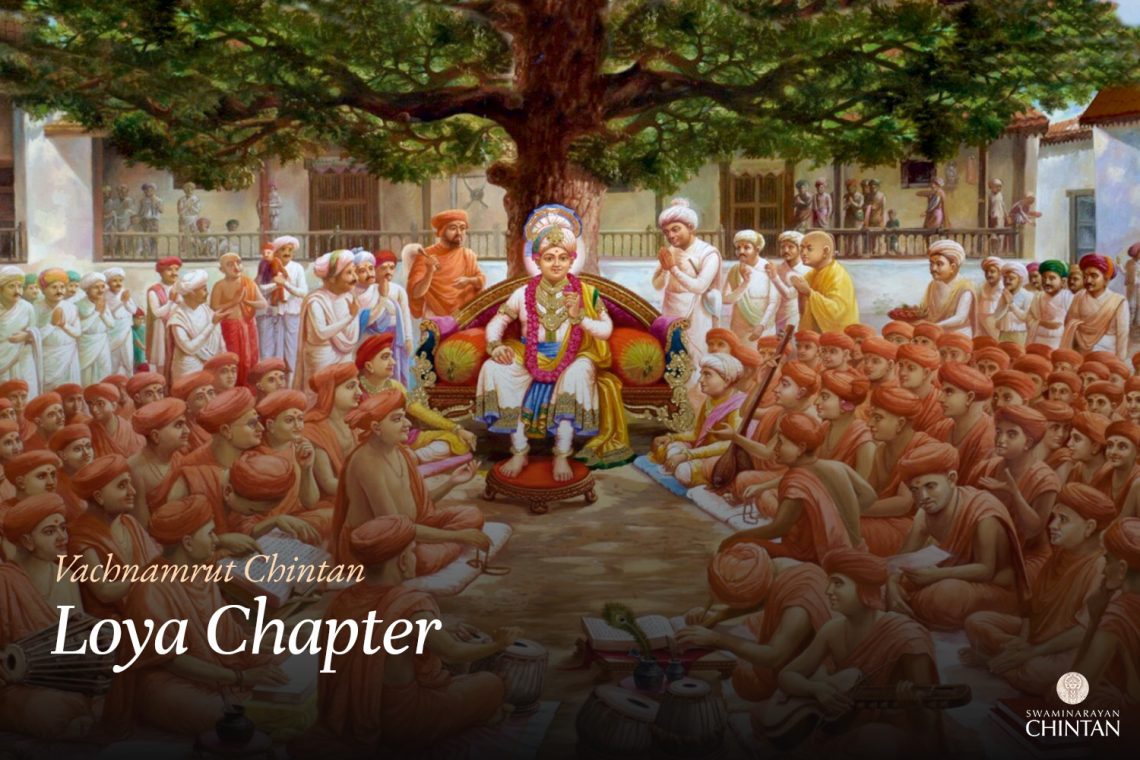Central Insights:
- Nischay in Bhagwan.
Main Points:
- First, understand the transcendental (para-svarup) form of God, and then focus on His manifest form with devotion.
- One must remove the human perception of Bhagwan’s manifest form and develop a divine perception. Further, transition from a divine perception to recognizing Him as Paramatma (Supreme Soul—God) and strengthen this conviction.
Commentary:
This Vachanamrut focuses on nischay (conviction or firm faith). Maharaj says that we must first decide what the original form of Bhagwan in His divine abode is like. Once this decision is made, a devotee should worship and engage in the upasana (wordship) of Paramatma’s incarnate form on Earth, while always keeping in mind His divine form as it exists in the abode. Scriptures mention that a devotee who worships in this way gradually becomes like Bhagwan in form and attributes.
Maharaj further explains that if a devotee worships incarnations like Varah, Matsya, Kurma, Nrusinh, Vaman, Vyas, etc., will they see Bhagwan in that same form in the divine abode? And will the devotee themselves become like Varah or Matsya? This clarity must be established in the heart of the devotee. If the contemplation of those forms leads to becoming one with that form, it should indeed happen. However, this is not the case. In reality, when the scriptures describe God’s divine abode, they do not depict such forms. The description is something entirely different. Thus, Maharaj explains that the original form of Bhagwan is one of Sachchidanand (existence, consciousness, and bliss). The essence of Bhagwan’s form is conscious, not composed of the five physical elements; it is a luminous form. Each aspect of God’s form radiates the brilliance of millions of suns, with beauty, grace, youthfulness, and attractiveness that would shame millions of Kamdevs (the god of love).
A devotee, when worshipping their Ishtadev (chosen deity), cannot fully grasp the form and beauty of Bhagwan with their senses and mind, as these faculties have limitations. Were they able to completely grasp Bhagwan, it would mean Bhagwan has become limited, which is contrary to the truth since His form is limitless, as stated by scriptures and saints.
Furthermore, Maharaj explains that Bhagwan is the master of countless universes and the king of kings. He is the center of all power in creation and the source of supreme bliss. The pleasures of this world and the next are insignificant compared to the joy derived from Bhagwan. Bhagwan is always in a two-handed form, but when necessary, He assumes the forms of Varah, Ram, Krishna, or other incarnations without discarding His original form. He incarnates with all His power and attributes, but devotees in this world may not perceive Him fully due to their limited understanding. Occasionally, He may reveal His forms, such as Chaturbhuj (four-armed) or Ashtabhuj (eight-armed), to a devotee by His will. However, the devotee must meditate on Bhagwan in His full form, focusing on His attributes and grandeur.
For example, in images of Matsya and other incarnations, the upper portion is depicted as human, complete with Chaturbhuj, holding Shankh, Chakra, Gada, and Padma (lotus), and adorned with Vaijayanti garland, Peetambar (yellow garment), crown, and the mark of Shreevatsa. This shows that Bhagwan’s form is not different in essence, but He assumes forms like Varah for specific purposes while maintaining His supreme form.
Bhagwan Shree Krishna revealed His divine form (para swarup) to Devaki, Akroor, Arjun, Uddhav, Rukmini, and others at various places. Similarly, Maharaj (Bhagwan Swaminarayan) displayed His divine form to His mother at birth, during her liberation, to devotees in the samadhi episode, to Muktanand Swami for confirmation of faith, to Vyapkanand Swami, and on numerous other occasions. Hence, when a devotee serves Bhagwan on Earth while recognizing His divine glory (para bhav), they attain the divine form of Bhagwan, not His earthly form. To perceive Bhagwan’s incarnate form or His murti with this divine understanding is what constitutes true nischay. It is said that “one who did not have nischay earlier has now developed it.” So, did they not see Bhagwan before? They did, but with a human or worldly perspective. They did not see Him with the understanding of His divine glory. Later, through the satsang of saints, they began to see Maharaj with this divine understanding, which is why it is said they have developed nischay.
Bhagwan possesses a supremely divine form, entirely devoid of any human characteristics. Therefore, one must remove human perception and instead bring divine perception—first seeing Bhagwan with the qualities of deities such as Brahma and other Ishwars, then with the attributes of Pradhan Purush and Prakruti Purush, leading to the divinity of Akshar. Ultimately, one must see Him as Purushottam beyond Akshar—this is the progression of developing nischay.
Maharaj gave an example of how the cowherds of Vraj developed conviction, showing that this is the gradual process of conviction. Thus, when perceiving Bhagwan’s murti or incarnate form, one should not let human perception interfere. How can one, who does not even see human traits in a devotee of Bhagwan, allow them to be seen in Bhagwan Himself? Just as a devotee who may be blind, crippled, or old in this world will not retain these traits in the divine abode, but will instead attain a divine form, so too must one remove human perception from Bhagwan. If anyone is confused about this, Maharaj says, they should be warned against such misunderstandings. Until this point is understood and nischay is firmly established, many uncertainties or weakness remain.
Maharaj further explains that even when speaking about one’s Ishtadev’s murti, there is often fear. This is because, after having established a connection with great difficulty, may hear something new and have their foundation shaken, causing them to lose faith. Hence, there is a fear in discussing such topics. You all must strengthen your nischay and discuss it daily—at least once a day. This is our command.
Glossary
| Nischay – Conviction or firm faith in Manifested God (Bhagwan Swaminarayan) |
| Para Svarup – Transcendental form The supreme, divine form of Bhagwan as He eternally resides in His divine abode—Sachchidanand Murti. |
| Upasana – Devotion through servant-master relationship Worship and devotion with the attitude of serving Bhagwan as one’s supreme master. |
| Ishtadev – Chosen deity |
| Sachchidanand – Existence, Consciousness, and Bliss |
| Kamdev – God of lust |
| Chaturbhuj – Four-armed form A specific form of Bhagwan where He is depicted with four arms. |
| Ashtabhuj – Eight-armed form A form of God manifesting divine powers for specific purposes. |
| Shankh-Chakra-Gada-Padma – Divine emblems held by Bhagwan Conch, discus, mace, and lotus— symbols of divinity and authority associated with Vishnu and His incarnations. |
| Peetambar – Yellow coloured garment A yellow cloth traditionally worn by Bhagwan in His divine form. |
| Shreevatsa – Auspicious chest mark A divine symbol present on the chest of Bhagwan’s murti. |
| Vaijayanti Mala – Garland of victory A divine garland symbolizing Bhagwan’s supreme authority and victory. |
| Akshar – Eternal Entity The highest spiritual reality beyond material existence, often associated with Bhagwan’ Swaminarayans divine abode. |

